
Ionospheric Modeling at URSI AP-RASC 2025
09-03-2025
Dima Paznukhov and Keith Groves, ionospheric scientists at BC’s ISR, presented their latest ionospheric modelling results from innovative data assimilation techniques at the 2025 URSI Asia-Pacific Radio Science Conference in Sidney, Australia. Groves’ talk, co-authored by ISR’s Alan Hoskinson & D. Paznukhov, described efforts to improve forecasts of the electron density of the background ionosphere. Paznukhov discussed modern analysis tools that several researchers at ISR and AFRL are developing to accurately specify ionospheric conditions more quickly. Paznukhov also chaired a session on the propagation of high-frequency radio waves through the ionosphere. Groves is currently the Chair of URSI’s Commission on Ionospheric Radio and Propagation (Commission G) and led the Commission G business meeting. He is also on the organizing committee for the triennial URSI General Assembly and Scientific Symposium 2026 which will take place in Poland next year.
Pictured above are Dima Paznukhov (left) and Keith Groves (right); photo courtesy D. Paznukhov.

BC/ISR Studies Earth’s Comm-Disrupting Ionosphere
07-22-2025
BC/ISR scientists Keith Groves and Teddy Surco spent part of their summer on a small island in the middle of the Pacific to use NASA rockets for studies of structures in the Earth’s atmosphere that disturb radio communications. Groves and Surco are part of the Sporadic-E Electrodynamics (SEED) mission led by Embry-Riddle Aeronautical University (ERAU) and funded by NASA. The disturbances occur in the “E layer” of the Earth’s ionosphere when trace metals such as iron, magnesium, and sodium, condense into dense clouds. These patchy clouds can disrupt the radio signals that communications systems depend on, for example, reflecting and distorting the signals between ground stations and satellites, or those used by air traffic controllers or military operators. The SEED project at ERAU, BC, and Clemson, uses sounding rockets to launch their instruments into the ionosphere to better understand the disturbing “sporadic E” phenomenon. The first SEED launch was June 20 and the second on June 28. While there, Groves and Surco also installed a magnetometer to support additional ionosphericresearch projects at BC/ISR.
Pictured above are Groves (left) and Surco (right); the first launch is shown in the inset. Photos courtesy NASA and Groves, respectively.

NASA’s PUNCH Mission at BC/ISR
06-30-2025
NASA’s PUNCH mission, launched in March 2025, has recently released images of its first solar storms known as “coronal mass ejections” or CMEs. When these storms hit the Earth, they can disrupt satellites and power grids, as well as causing the aurorae that many of us have enjoyed seeing the last few years. ISR’s Dave Webb co-leads the PUNCH working groups that will use the new satellites to study the structure and evolution of the CMEs. PUNCH, the Polarimeter to Unify the Corona and Heliosphere, is a constellation of 4 small satellites, each about the size of a large suitcase. Together, they will produce deep-field, continuous, 3D images of the solar corona as it makes a transition to the solar wind. This new perspective will allow scientists to discern the trajectory, speed and internal structure of the solar wind and coronal mass ejections as they move through the inner solar system, improving our understanding of the ambient and dynamic solar wind and their space weather effects. The mission is led by SwRI and UCAR; more information can be found at the team website.
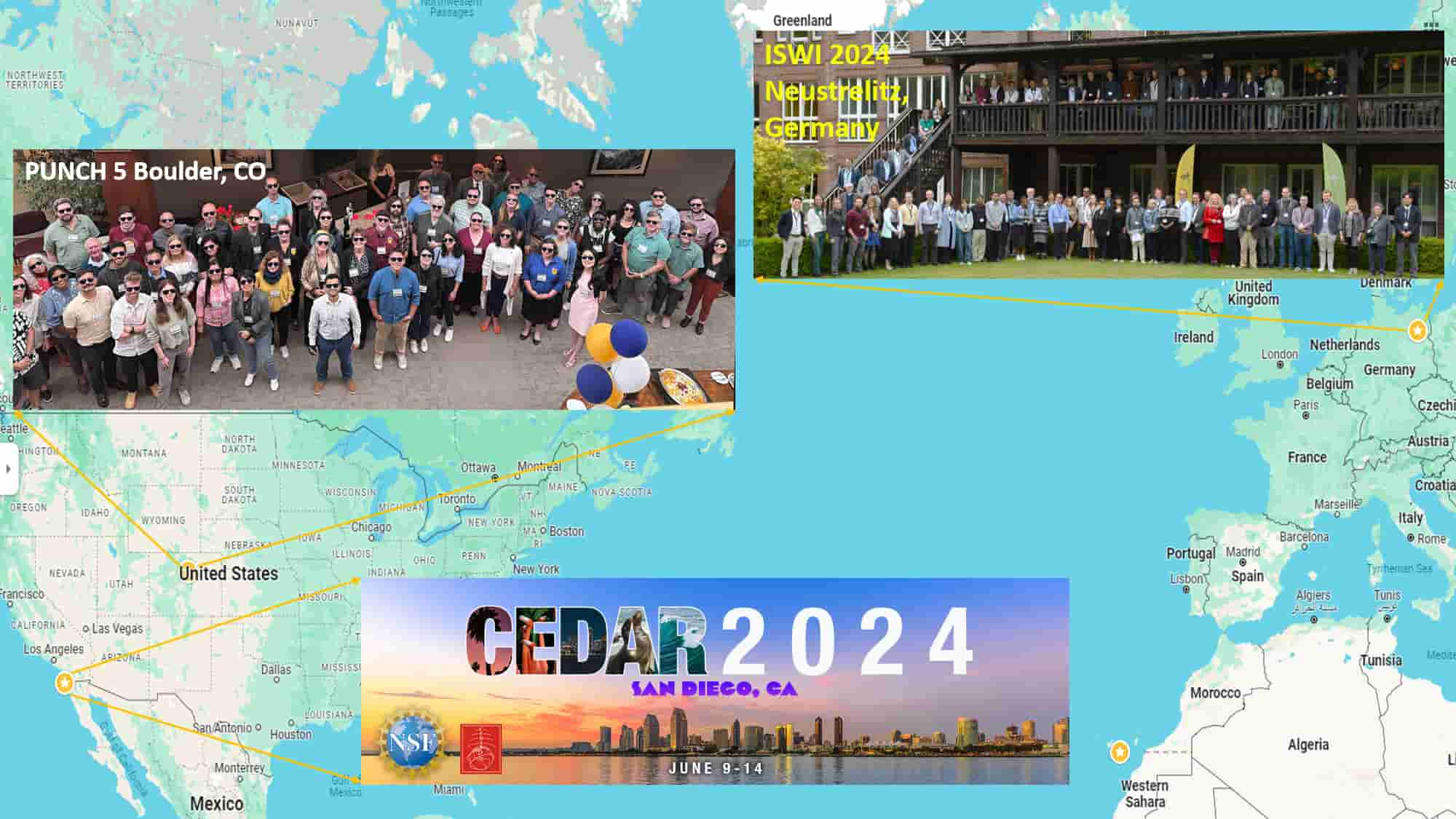
ISR at Space Physics Workshops - June 2024
06-30-2024
June 2024 saw BC/ISR scientists attending several workshops on space physics research. D. Webb is team lead for coronal mass ejections (CMEs) on the NASA PUNCH mission (Polarimeter to UNify the Corona and Heliosphere), due to launch this coming spring. He attended the PUNCH 5 team workshop in Boulder, CO in June, working on a pre-launch paper on CMEs for the journal “Solar Physics”. R. Pradipta and K. Groves participated in the 2024 CEDAR workshop in San Diego. CEDAR (Coupling, Energetics, and Dynamics of Atmospheric Regions) is an NSF program to investigate the space-atmosphere interaction region, including ionosphere-thermosphere predictability. K. Kraemer attended the 2024 ISWI workshop in Germany, presenting an overview of the SPARTA program, the NASA Space Weather Center of Excellence led by BC/ISR’s K. Groves (Space Weather Research and Technology Applications).
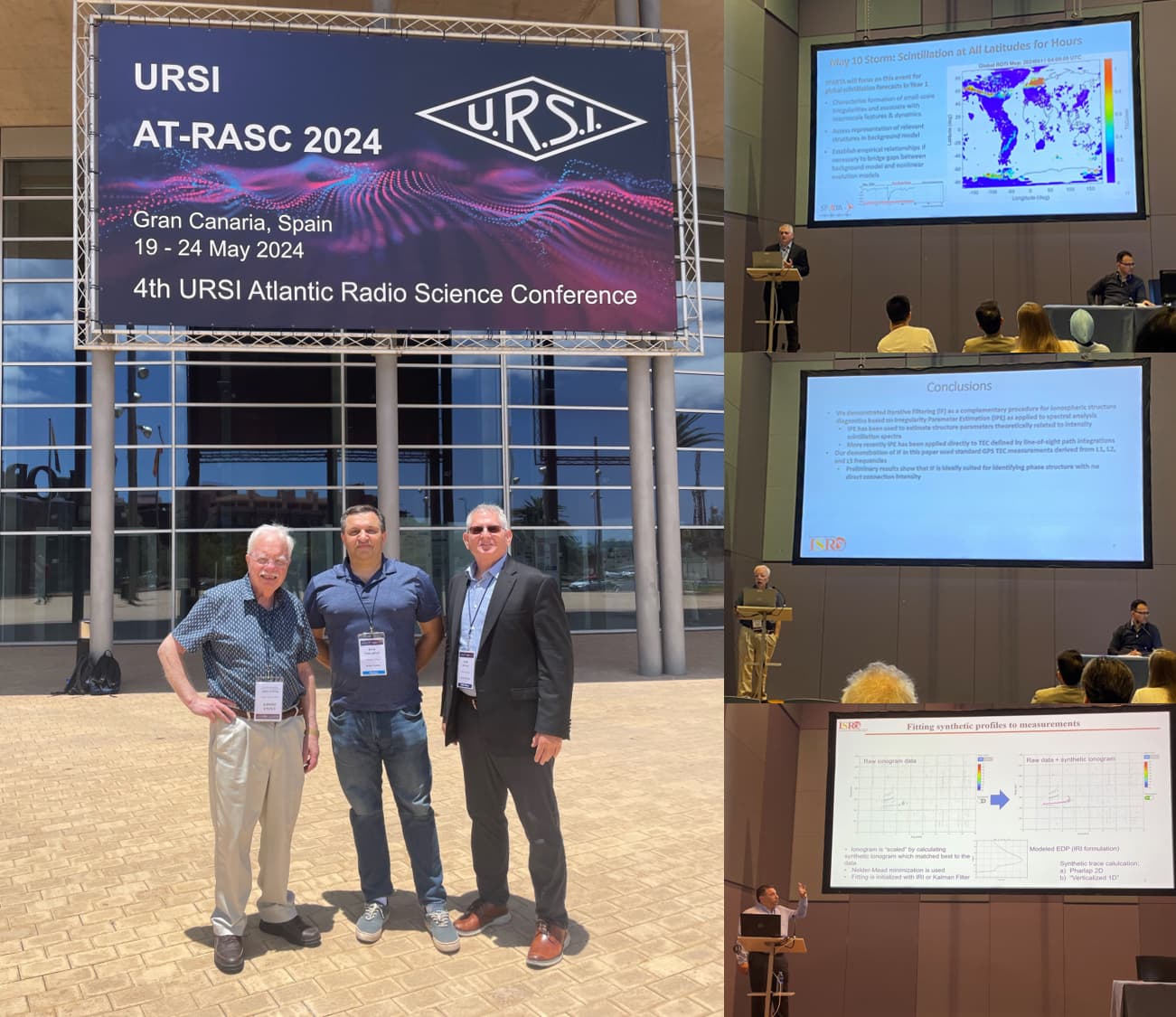
ISR at URSI AT-RASC 2024
05-31-2024
Just after the biggest geo-effective storms of the current solar cycle hit the Earth on May 10 (aka, the Mother’s Day storm), BC/ISR scientists K. Groves, A. Hoskinson, D. Paznukhov, & C. Rino presented their ionospheric research at the 2024 URSI Atlantic Radio Science Conference. Rino, Paznukhov, & Groves (left to right in the photo) traveled to Spain for the conference, while Hoskinson presented remotely. Their research provides insights on how such storms affect the ionosphere and how that can disturb satellite communications and navigation systems. Groves is the current chair of URSI Commission G, Ionospheric Radio and Propagation and supported board meetings and tutorials for the conference.
Photos: left panel shows Rino, Paznukhov, & Groves (left to right); right panel shows Groves, Rino, & Paznukhov presenting their work (top to bottom)

ISR Activities in April 2024
04-30-2024
April 2024 saw members of BC/ISR traveling across the country to catch the total solar eclipse, including Vermont, New York, and Ohio. Closer to home, we provided eclipse glasses & answered questions from BC students and staff in the BC Law parking lot and on main campus where it reached ~93%. ISR’s Newton-based ionospheric monitoring equipment detected signal changes in the data due to the eclipse that are currently being analyzed by D. Paznukhov. Also in April, ISR postdoc Teddy Surco Espejo (top left) went to Manila, Philippines for the UN/Philippines Workshop on the Applications of Global Navigation Satellite Systems (GNSS), where he gave a talk on his research on using ROTI to estimate ionospheric scintillation, co-authored by IRS’s Charles Carrano & Keith Groves. Scintillation can cause errors in GPS signals, for example, and compromise the accuracy of positions and timing. Associate Director Keith Groves attended the 2024 Space Weather Workshop in Boulder, Colorado, presenting an overview of SPARTA, BC/ISR’s new NASA Space Weather Center of Excellence, which is also focusing on improving scintillation predictions.
Image credits: top-left & center: T. Surco Espejo; lower-right: SWW 2024; ionospheric data: D. Paznukhov
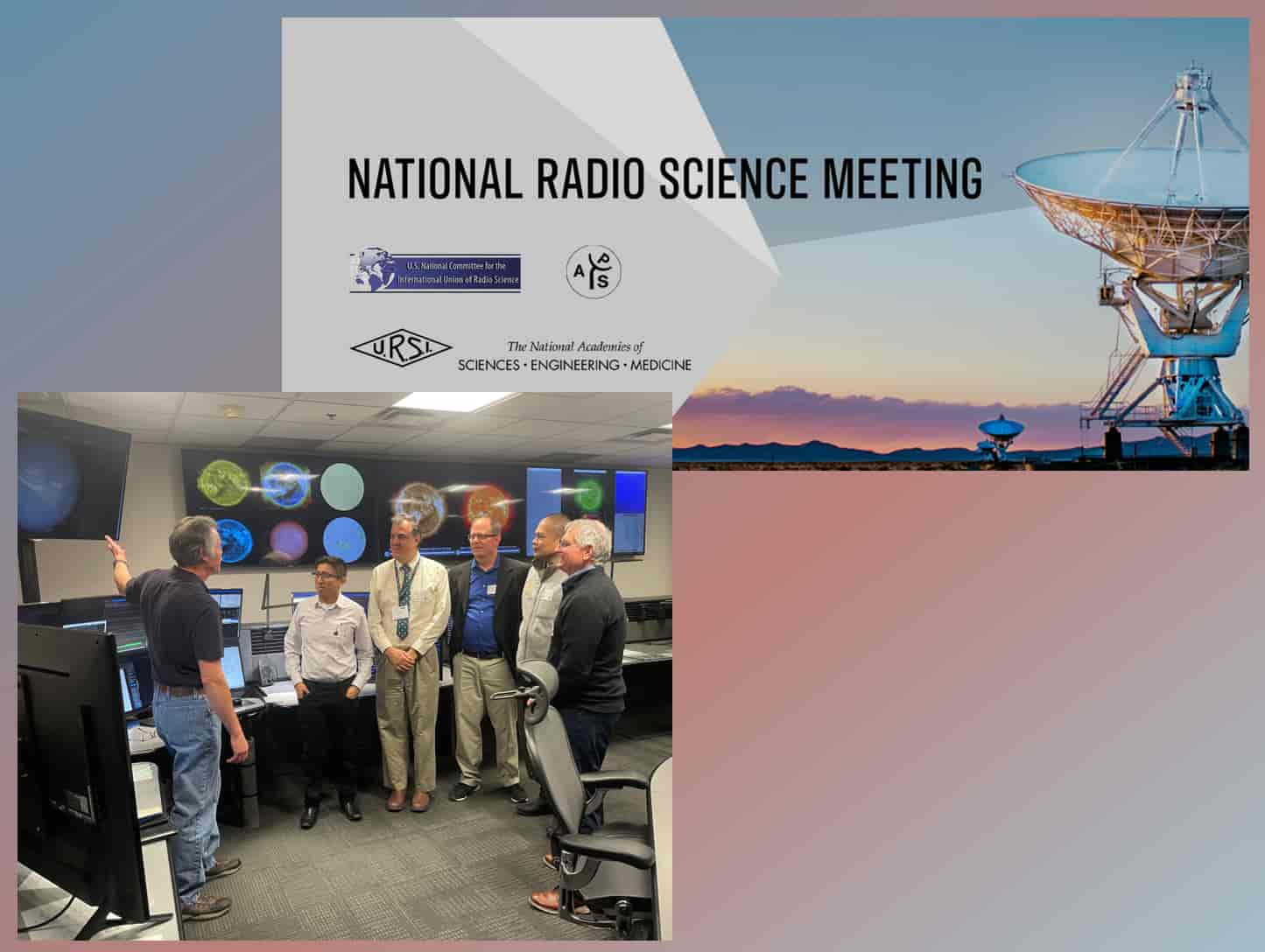
The USNC-URSI 50th Anniversary Meeting
01-22-2024
BC/ISR researchers took part in the 2024 National Radio Science Meeting in Boulder, helping to celebrate the 50th anniversary with the US National Committee for URSI, the International Union of Radio Science. Keith Groves chaired the special session “Beacon Satellite Science and Applications: In Memory of Patricia Doherty” – the late ISR Director. Several ISR scientists gave talks at the session, including Groves, Charlie Carrano, Ted Beach, Teddy Surco Espejo, and Rezy Pradipta. Chuck Rino chaired the “Ionospheric Radio and Propagation” session and presented a talk. Matt Proctor, Chris Bridgwood, and Dima Paznukhov were co-authors for a number of the talks, and Groves participated in the US Commission G Business Meeting as the Chair of the international commission. While in Boulder, they took the opportunity to visit NOAA’s Space Weather Prediction Center.
Pictured from left to right: Dahl (SWPC), Surco Espejo, Carrano, Beach, Pradipta, and Groves. Photo courtesy of Groves.
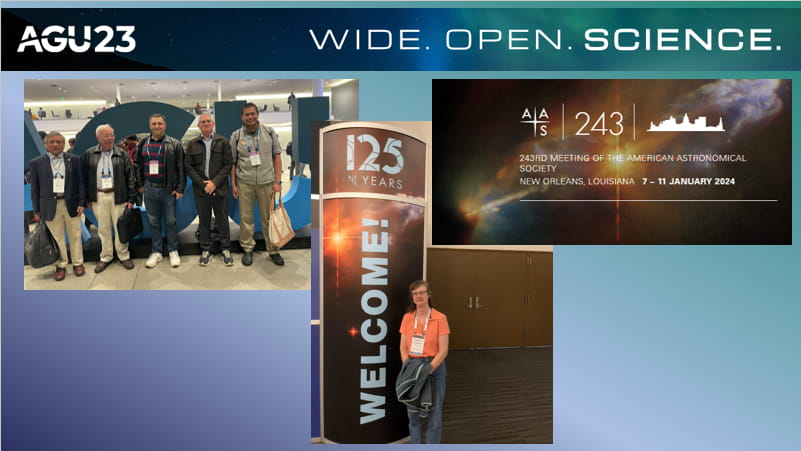
Winter Meetings in the Space Sciences
01-15-2024
This winter, ISR researchers have shared their research results at conferences across the country. At the annual meeting of the American Geophysical Union (AGU) in San Francisco, December 2023, Keith Groves, Dima Paznukhov, Rezy Pradipta, and Samuel Schonfeld each presented posters on their ionospheric and solar physics investigations. Other ISR researchers were also co-authors on talks and posters, including Ted Beach, Charlie Carrano, Matt Proctor, and John Retterer. In January, Kathleen Kraemer traveled to the 243rd meeting of the American Astronomical Society in New Orleans, where she presented a poster on infrared spectral databases, co-authored by BC undergrad Holly Branco along with summer students Elianna Cohen (GT) and Samatha Greene (ERAU).
Pictured above (from left to right): Cesar Valladares (former ISR scientist), Chuck Rino, Dima Paznukhov, Rezy Pradipta (at AGU) and Kathleen Kraemer (at AAS). Photos courtesy Groves & Kraemer.
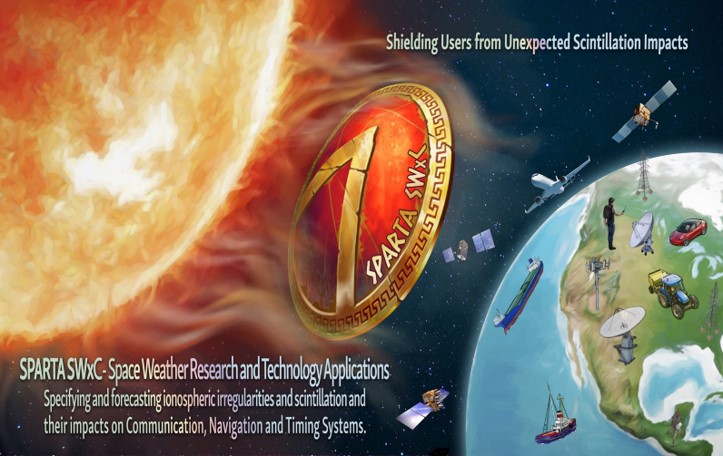
SPARTA: BC/ISR Selected for 5-Year Space Weather Center of Excellence by NASA
10-30-2023
We are excited to announce that BC's Institute for Scientific Research (ISR) has been selected by NASA to host a new Space Weather Center of Excellence (SWxC). The new SWxC, “SPARTA” (Space Weather Research and Technology Applications), will be measuring and forecasting ionospheric disturbances, especially scintillation events, and their impacts on communications, navigation, and timing systems such as GPS, in part using machine learning techniques. A major goal of the SWxC is to improve global forecasts of scintillation in order to provide better alerts and prevent disruptions to communication and navigation applications. Led by the PI Keith Groves, the SPARTA team includes members at institutes across the country and around the globe, with experts from academia, government, and industry. For additional details, please see the BC News article.
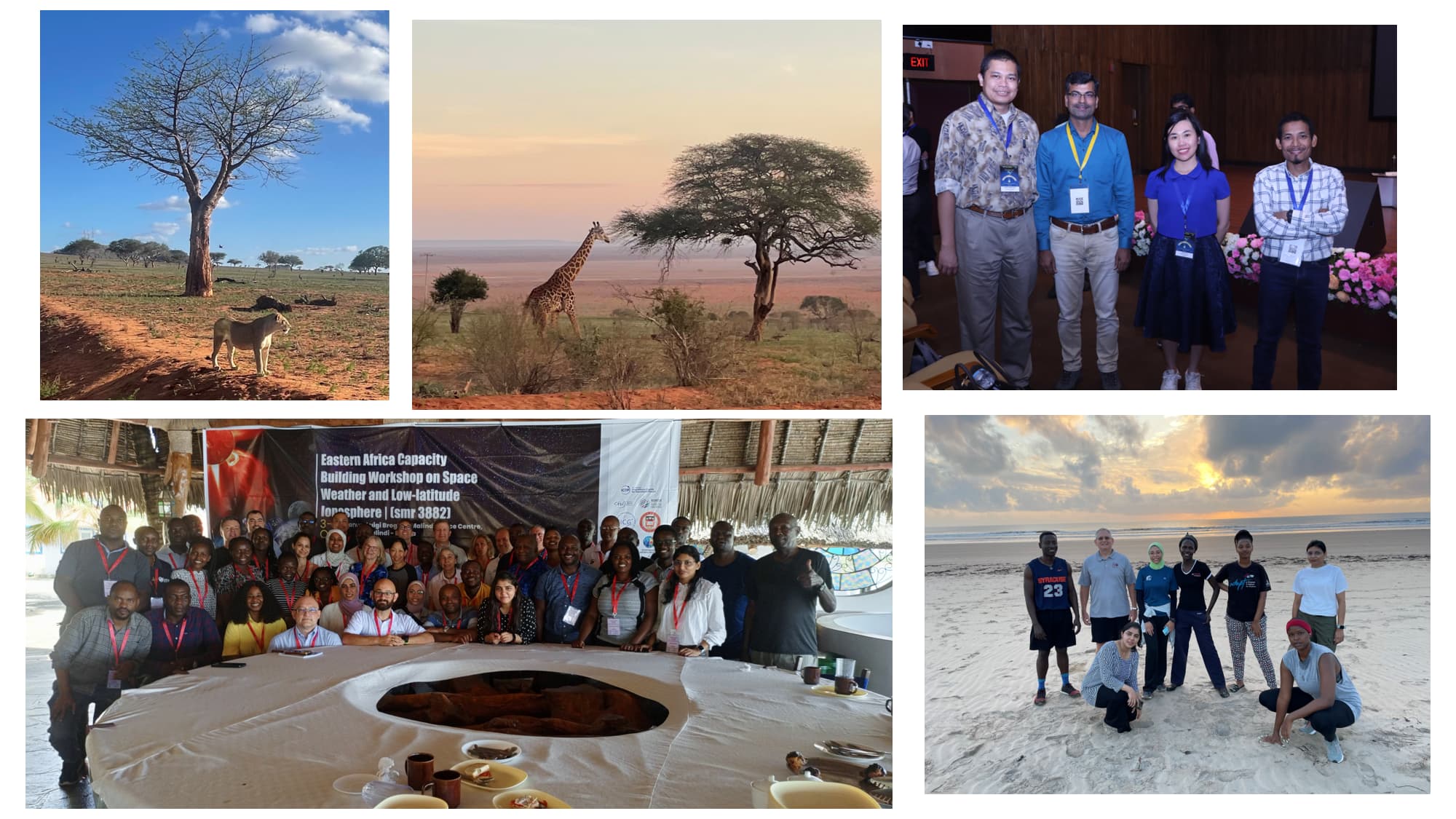
Building Global Capacity with BC/ISR Science
10-30-2023
This fall, ISR scientists gave lectures and invited talks at short schools and workshops in India and Kenya. K. Groves and R. Pradipta went to the Eastern Africa Capacity Building Workshop on Space Weather and Low-latitude Ionosphere at the Malindi Space Center, Kenya, in early October. K. Groves, who was also one of the Workshop Directors, lectured on ionospheric irregularities and their characteristics. R. Pradipta gave hands-on demonstrations of measurements using low-cost receivers developed at ISR. Pradipta was also an invited speaker at the 3rd International Workshop on Equatorial Plasma Bubbles (EPB-3) at the Indian Institute of Geomagnetism (IIG) in Navi Mumbai, India in September. He discussed the hazards of equatorial plasma bubbles and improving public awareness of them.
Photo credits K. Groves & R. Pradipta. Top row (left+center): a Kenyan safari over the weekend; right: at the EPB-3 from left to (right) Pradipta, Gopi Seemala, Tam Dao, & Prayitno Abadi. Bottom row (left) group photo (right) morning jogging group
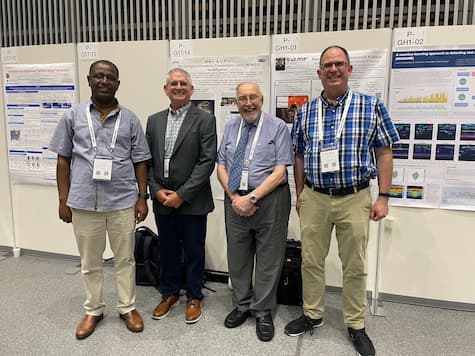
XXXVth URSI GASS in Sapporo, Japan
09-01-2023
Ionospheric scientists K. Groves, T. Beach, and S. Radicella of BC’s ISR traveled over 6,000 miles to Sapporo, Japan to the 35th General Assembly & Scientific Symposium (GASS) of the International Union of Radio Science (URSI), Aug. 19-26, 2023 to present their research. Groves described efforts to forecast “spread F”, an irregularity in the ionosphere that can interfere with radio communications that he and BC/ISR co-authors J. Retterer, C. Carrano, and C. Bridgwood are investigating. Beach discussed monitoring ionospheric “scintillation”, radio wave fluctuations that stem from ionospheric irregularities like spread F, evaluating commercial GNSS receivers along with BC/ISR’s Groves, Bridgwood, M. Proctor, and D. Paznukhov. S. Radicella gave an invited talk on promoting radio science in developing countries in partnership with the late P. Doherty, BC/ISR’s former director. Groves also participated in the USRI Commission G committee meeting, where he was serving as Vice Chair. Congrats are due as he is now the newly elected Chair through 2026! They also ran into E. Yizengaw, a former BC/ISR scientist who currently works at Aerospace Corp. Pictured in the photo from left to right: Yizengaw, Groves, Radicella, and Beach (photo courtesy K. Groves).

Summer Conferences for ISR Researchers
08-04-2023
The summer of 2023 has seen several BC/ISR scientists travel across the country and around the world to present their research. In June, Kathleen Kraemer gave an invited review talk on stellar evolution with SOFIA observations at the 242nd meeting of the American Astronomical Society (AAS) meeting in Albuquerque, NM, Teddy Espejo Surco presented his research on ionospheric phase scintillation at the annual workshop for Coupling, Energetics and Dynamics of Atmospheric Regions (CEDAR) in San Diego, CA, and Keith Groves presented work on low-cost instruments for space weather monitoring at the UN Workshop on the International Space Weather Initiative (ISWI) in Vienna, Austria. July found Dave Webb attending the science meeting for the Polarimeter to Unify the Corona and Heliosphere (PUNCH) mission in Boulder, CO, while Groves was in Berlin, Germany for the General Assembly of the International Union of Geodesy and Geophysics (IUGG) and for the Bureau meeting of the Scientific Committee on Solar-Terrestrial Physics (SCOSTEP).
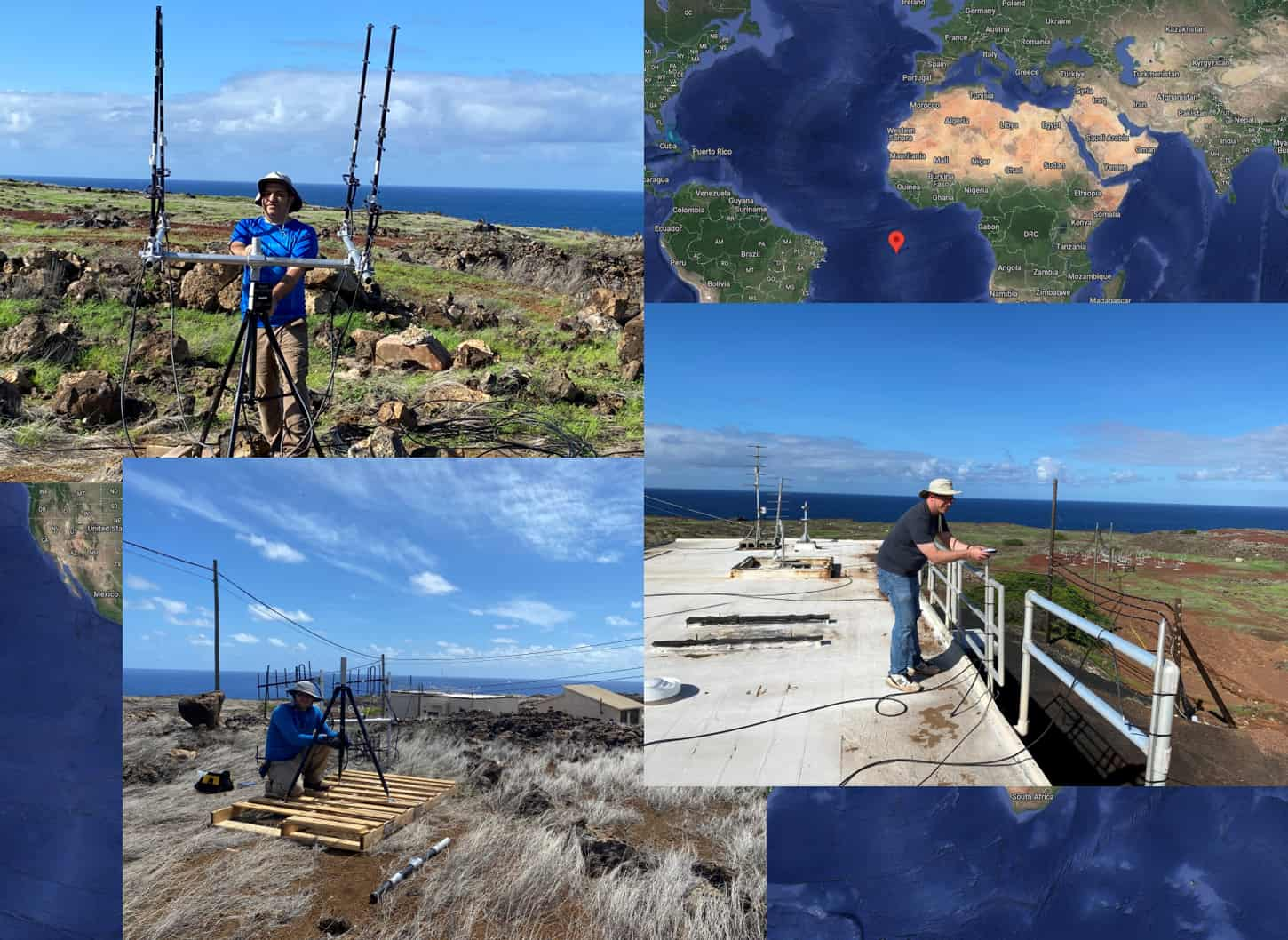
Follow-Up Visit to Ascension Island 2023
05-22-2023
After a few weather-related delays, BC/ISR scientists Ted Beach, Dima Paznukhov, & Matt Proctor were able to travel to Ascension Island (in the middle of the Atlantic Ocean) for upgrading and installation of additional ground-based systems for recording satellite signals. The original set was installed in December 2022, and the latest upgrades and additions will enable further study of the impact caused by equatorial plasma bubbles in the ionosphere on satellite radio transmissions, primarily GNSS signals. During the visit, which was during the strongest ionospheric disturbance activity period, a full-scale measurement campaign on data collection was carried out, allowing acquisition of a large volume of data (tens of TB) which is currently being analyzed by our scientists at BC.
Photos: clockwise from the right: T. Beach, M. Proctor, D. Paznukhov; photo credit: D. Paznukhov; background map from Google maps.

Ionospheric Effects Symposium 2023
05-22-2023
The 2023 Ionospheric Effects Symposium, co-sponsored and organized by BC/ISR, took place 9-11 May 2023 in Alexandria, VA. More than 70 scientists from countries around the world, including several from ISR, gathered to discuss the ionosphere and space weather. A key focus of the symposium was how to transition the scientific results to practical applications and operation uses. Congratulations are due to the winners of the Best Papers Awards: Joe Helmboldt (Best Overall Paper) and Austin Egert (Best Early Career Scientist Paper). Honorable Mentions went to Early Career Scientists Teddy Surco Espejo and Joe Hughes. Additional details are on the Symposium website, and the organizers remind authors to submit their proceedings papers to Zenodo!
Photo credit: K. Kraemer
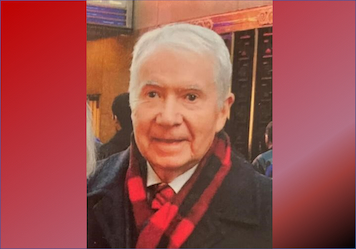
Passing of Charlie Pike
02-23-2023
We are saddened to hear that Charles “Charlie” Pike Jr. has passed away. Charlie was a valued member of BC/ISR for several years, having returned to BC after retiring from AFRL in 2008. In addition to sharing his scientific expertise in ionospheric physics with his colleagues, he also enjoyed recruiting BC undergrads for our research projects, being a BC alum himself (Class of ’63) and wanting to pass on his passion for science to the students. His obituary can be found here. He will be missed by all of us.
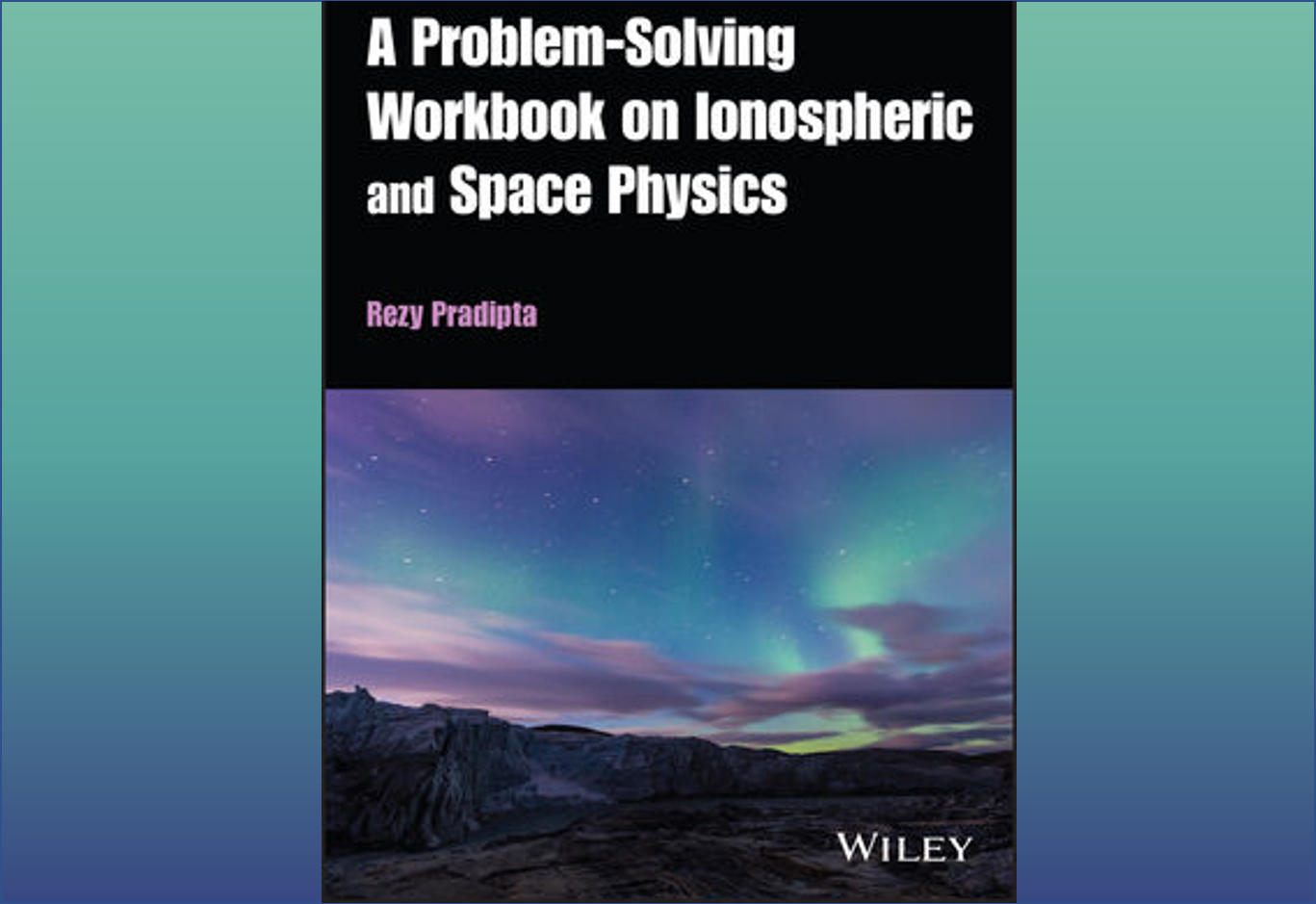
New Ionospheric Book Published by R. Pradipta
02-03-2023
We are happy to announce the release of a new book on the ionosphere by Rezy Pradipta, Senior Research Scientist at BC/ISR. The book, A Problem-Solving Workbook on Ionospheric and Space Physics, contains topical problems and exercises in ionospheric and space physics, with solutions included. Topics include sensing ionospheric plasmas, ionospheric layer formation, acoustic-gravity waves, radars, GPS, and ionosondes, to name a few. Intended for advanced undergraduate students, graduate students, and early-career researchers, it is available in paperback and e-book formats from Wiley.

Boston College at the American Astronomical Society Meeting #241
02-02-2023
BC/ISR astronomer Kathleen Kraemer (above left) recently attended the 241st Meeting of the American Astronomical Society in Seattle, WA. She presented an e-poster on detecting water in cool evolved stars with SOFIA, NASA’s now-retired flying telescope, along with BC/ISR’s Tom Kuchar and former BC/ISRer Greg Sloan (above right). Kuchar, attending virtually, presented an e-poster on observations of the Small Magellanic Cloud, co-authored by BC/ISR’s Don Mizuno, Kraemer, Sloan, and their colleagues. Kraemer was a co-author on three other e-posters and chaired sessions on evolved stars, dust, and stellar physics.
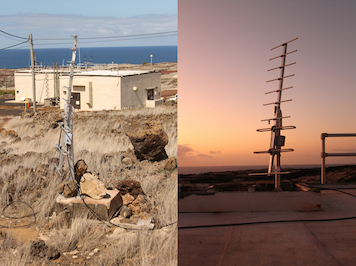
BC/ISR Antennae Installation on Ascension Island
01-19-2023
BC/ISR engineers Ted Beach and Matt Proctor traveled to the middle of the Atlantic Ocean in early December to install a new set of BC-built receivers and antennae on Ascension Island. The equipment will carry out multi-frequency observations of "scintillation" caused by equatorial plasma bubbles in the ionosphere. Scintillation is random fluctuations in phase and amplitude that occur when radio signals, like GPS signals at L band (1 - 2 GHz), propagate through ionospheric plasma turbulence. BC/ISR is evaluating the impact of these scintillations on space-based communications and navigation systems. Ascension Island is a great place to study the phenomenon because it routinely experiences some of the highest L-band scintillation levels in the world during solar maximum periods, which we are now approaching.
Photo credit: T. Beach

BC/ISR Research at AGU 2022
12-20-2022
Several BC/ISR scientists presented their research at the recent AGU Fall Meeting in Chicago, IL. Sam Schonfeld (above right) presented his poster on magnetograms and co-chaired sessions on the dynamic solar wind, while Rezy Pradipta (above center) co-authored a poster with his summer student, Bryce Kim (above left) from Bozeman High School, along with co-convening a session on subauroral geospace. John Retterer (not pictured) gave an invited talk remotely on ionospheric models, and other BC/ISR researchers also participated remotely as co-authors on several posters on their ionospheric and solar research projects.
Photos courtesy of R. Pradipta and S. Schonfeld
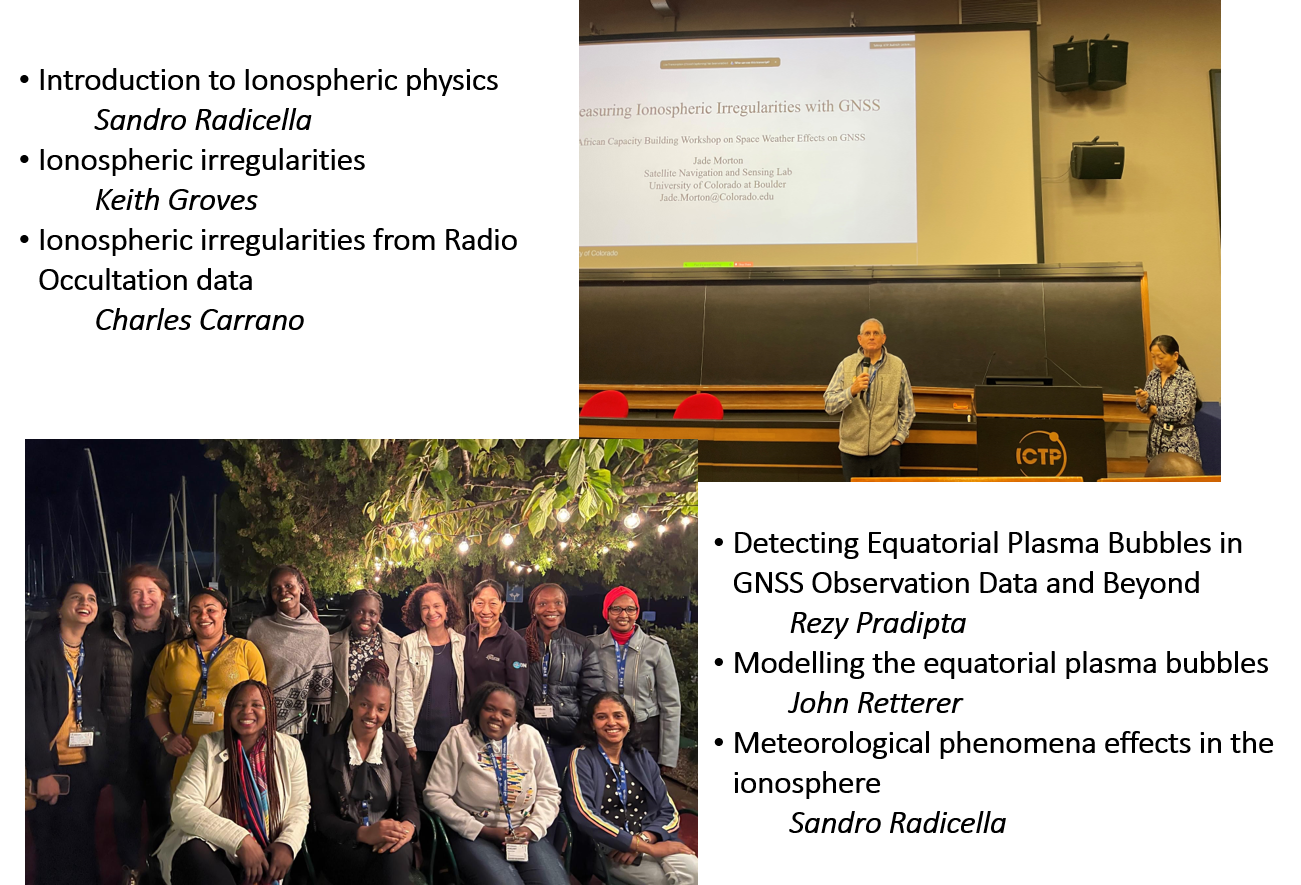
2022 African Capacity Building Workshop on Space Weather Effects on GNSS
10-27-2022
The 2022 African Capacity Building Workshop on Space Weather Effects on Global Navigation Satellite Systems (GNSS), co-sponsored by BC/ISR, took place 3-14 October 2022 at ICTP in Trieste, Italy. As with many previous GNSS events aimed at enhancing the knowledge and research capacity of young scientists, especially from Africa, the late Patricia Doherty was a key organizer of the workshop. ISR's Keith Groves, who also helped organize the event, traveled to Trieste to serve as a meeting director, session chair, and lecturer. Several other ISR scientists gave lectures and tutorial on aspects of GNSS, how space weather affects those signals, and how those effects signals can be used for studies of the ionosphere: Charles Carrano spoke on irregularities and radio occultation data; Rezy Pradipta discussed plasma bubble observations; John Retterer lectured on plasma bubble theory; and Sandro Radicella gave both the introductory lecture on ionospheric physics and a tutorial on meteorological phenomena effects in the ionosphere. Over 125 participants both in-person and on-line from 28 different countries attended the lectures & tutorials, and took part in projects to learn analysis techniques for using GNSS data for their own ionospheric investigations. The Women's Dinner, a favorite event of Pat's, was hosted this year by Dr. Jade Morton from the University of Colorado, Boulder and Yenca Migoy-Orue of ICTP with the support of Boston College.
Photos courtesy of K. Groves, Y. Migoy-Orue, and J. Morton.